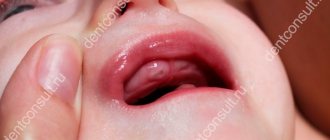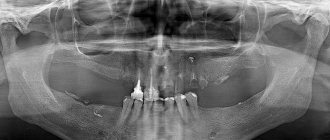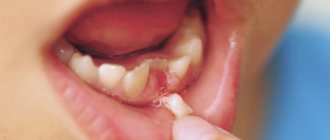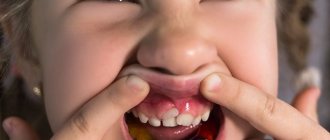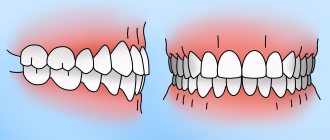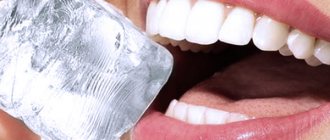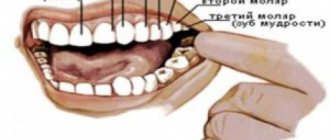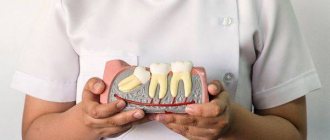Not the most common, but nevertheless occurring, dental defect is when the front teeth, the most important for the “smile line,” are different in length, and one is noticeably shorter than the other. Sometimes this is even more noticeable than the usual unevenness of the front teeth, leads to psychological discomfort and impaired diction, and in addition, it is fraught with dental health. After all, the load on the front incisors is uneven, which ultimately can lead to problems with loosening and loss of teeth.
What to do if your teeth are of different lengths, and how to fix it?
Ideal teeth size
In dentistry, teeth of a certain size and anatomical shape are considered normal, depending on the size of the jaw and their location in it. They must be smooth, fit tightly to each other and have a thickness within certain limits: for example, the height of the lateral incisors in an adult is normally 7 - 11 millimeters. Of course, this does not mean that they need to be measured with a ruler - overall aesthetics and proportionality are much more important (for example, for people of short stature and fragile build, a small teeth size is appropriate). Many parents are interested in why their child has small teeth, but usually there is no reason to worry: normally, the baby incisors are small and located at a distance from each other.
However, if the patient really has very small teeth, you should definitely consult a dentist to confirm or exclude the diagnosis of microdentia.
Milk teeth and their features
Temporary and permanent teeth have certain differences in structure. The shape of baby teeth is the same as in molars (permanent), but their size is much smaller, the roots are shorter, and the number is different - there are only 20 of them versus 32 permanent teeth (including wisdom teeth). “Children’s” teeth are characterized by a short service life: their roots dissolve over time (as dentists say, “resorb”) approximately 2-3 years after they are fully formed. This process begins with the area touched by the crowns of the permanent teeth growing underneath them.
But it happens that for one reason or another the formation of the rudiments of permanent teeth does not occur. In this case, the roots of baby teeth are more often resorbed as a result of the influence of the rudiments of permanent adjacent teeth. But it happens that this does not happen and “children’s” teeth can then remain in adults - dentists call them persistent (translated from Latin persistere - to remain, to remain).
Diagnosis of microdentia
According to statistics, about 5% of people face the problem of microdentia – abnormally small teeth in an adult. There are several signs that allow you to distinguish microdentia from other dental pathologies.
Symptoms of microdentia
- teeth of regular shape, but with a significantly reduced crown;
- distances between teeth visible to the naked eye;
- damage mainly to the front teeth;
- wavy or jagged shape of the cutting part of the affected tooth.
In most cases, the presence of microdentia can be determined by visual examination of the patient, but for a more accurate diagnosis, hardware diagnostics are performed. For example, the doctor can measure the overall width of the incisors of both jaws using a special instrument, as well as resort to x-rays. A deviation is considered to be a reduction of teeth by 1.5 mm or more relative to the norm. Based on the results of the examination, one of three types of microdentia is determined.
Isolated
If the patient has one or two small teeth, then we are talking about isolated microdentia. Most often, the front incisors (mainly the lateral incisors) are underdeveloped.
Relative
Relative microdentia is said to occur when the patient has an abnormally enlarged jaw. On such a jaw, even normal-sized crowns can look disproportionately small. Thus, relative microdentia is an overly large gum and small teeth on it.
Generalized
In the most severe cases, when small teeth are located throughout the jaw, the patient is diagnosed with “generalized microdentia.”
Complications after filing teeth
If the manipulation is carried out in a dental office under the guidance of a qualified specialist, there is a small chance of a mild complication in the form of a temporary increase in sensitivity. All reviews of teeth filing prove that the side effect goes away quickly and does not cause concern.
To avoid any complications and side effects, you should not try to file your teeth at home. Attempts to use improvised tools to correct the dentition often cause chipping of enamel particles, the appearance of cracks and damage to several teeth at the same time. Successful and high-quality sharpening of teeth is possible only with diagnostics, professional dental instruments and therapeutic agents.
Reasons why teeth become small
As a rule, most of the reasons leading to the appearance of small front teeth in adults come from childhood, when pathological processes interfere with the formation of body systems. Microdentia can be a consequence of:
- severe infections suffered before the age of 2 years;
- exposure to radiation;
- inflammatory diseases in the mother during pregnancy;
- early removal of baby teeth;
- underdevelopment of the alveolar ridge and, as a consequence, lack of sufficient support for “growing” teeth of normal size.
Delete or leave?
Milk teeth have reduced resistance to the development of caries and other diseases. These teeth are not designed to last. They can interfere with neighboring teeth and visually look different from molars, which disrupts the aesthetics of the smile.
If you find a baby tooth, contact your dentist. The doctor will assess the condition of the tissue and location, degree of destruction and the need for removal. If there are no indications for removal, the dentist will not prescribe this procedure.
Baby teeth are left if:
- the tooth is well preserved and does not interfere with the rest;
- The molar tooth germ is missing, but the roots of the temporary tooth remain intact.
To determine this, the patient needs to undergo an X-ray diagnosis or undergo a 3D tomography. The image will show whether there are prerequisites for the eruption of a permanent tooth, and what is the condition of the milk root.
Dangerous consequences of microdentia
At first glance, it seems that small teeth in an adult cause only aesthetic inconvenience, but this is not so. Dentists identify several quite serious problems that microdentia can lead to.
- Distal displacement of teeth,
that is, their gradual shift back relative to the optimal position in the jaw. - The appearance of gaps between the teeth
(the so-called diastemas and threes), which lead to disruption of the contact of the lateral surfaces of the teeth. Without support, the ligaments in the dental bed stretch and the tooth becomes unstable. - Diction disorders,
excessive amplification of hissing and whistling sounds in speech. - Periodontal disease
is a disease of the soft tissues of the jaw, caused by accumulations of bacteria in the interdental spaces and an enlarged periodontal pocket due to the high mobility of the tooth.
Reasons for the growth of the second dentition in a child
Double or “shark” teeth in children appear when the baby tooth and the rudiment of the molar are located at different points in the oral cavity. When a new set erupts, the baby tooth remains in place. A tooth grows above a tooth, which not only does not look aesthetically pleasing, but also interferes with the development of the rest of the row.
The most common reason why teeth do not change is improper breathing. A lot depends on how a child breathes. Breathing disorders lead to problems with bite, deterioration of posture and changes in facial shape.
A child’s jaw develops correctly only when he breathes correctly through his nose. The tongue in this position presses on the palate from the inside. A natural semicircular shape of the jaw is formed, in which there is enough space for all the molars. This is why it is so important to teach your child to breathe through his nose to prevent the growth of the second row of teeth.
How to fix small teeth?
Small tooth: what to do if it causes inconvenience, reduces self-esteem and worsens quality of life? Depending on the severity of the picture, the dentist may suggest the following correction methods:
- In case of isolated microdentia, small teeth can be corrected by installing veneers or lumineers - thin plates that are attached to the front surface of the tooth. This method is also suitable for eliminating threes and diastemas and increasing the width of the visible part of the crown. If your teeth grow unevenly, you will most likely need orthodontic correction using braces before placing veneers.
Supernumerary teeth in children
The appearance of additional tooth buds is rare, occurring in only 2% of cases. The anomaly is associated with a disorder of embryonic development. A tooth that appears above a child's tooth is usually removed. But this does not always happen: if the tooth does not disturb the shape and aesthetics of the dentition, the dentist can leave it.
Sometimes supernumerary teeth are located outside the dental arch. The appearance of a tooth on the palate of a child is rare, however, this is no exception. There is no need to be afraid of this: it does not affect your health in any way. The Natadent clinic has a pediatric orthodontist who will help solve this problem quickly and painlessly.
Causes of polyodontia
Medicine has not yet found an exact answer to the question of what are the causes of supernumerary teeth. Scientists put forward several hypotheses:
- Atavism. Supernumerary teeth are explained by the fact that the dental system strives to return to the original number of elements laid down by nature. There is evidence that our ancestors had 6 incisors on both the lower and upper jaws. As a result, many doctors consider atavism to be the cause of the development of polyodontia in humans.
- Splitting of the tooth germ. Even in the embryonic period, the activity of the dental plate is disrupted in the child, as a result of which hyperdontia is formed. Violations can be caused by viruses, poor ecology, drugs, medications prohibited during pregnancy, alcohol and other factors. This hypothesis is increasingly supported today, because recently the disease has been rapidly progressing due to bad habits and poor ecology.
The causes of hyperdontia continue to be researched. Scientists cannot give an exact explanation for this anomaly, but most of them are inclined to the second hypothesis - the splitting of the tooth germ at the embryonic stage.
Prevention of recurrence of diastema
Relapses in orthodontic treatment, unfortunately, occur frequently. This is especially frustrating considering how much time and money is involved in fixing the problem. In the case of diastema, its appearance can be caused by various reasons. The most common are incorrectly selected treatment and neglect of the orthodontist’s recommendations during the retention period.
Sometimes patients refuse the necessary surgical treatment or wearing braces, and insist on “simple” correction methods, for example, installing crowns or masking the gap with composite materials. But since the problem remains unresolved, the diastema will return.
Likewise, she will not keep you waiting if, after treatment, the patient decides to ignore the orthodontist’s recommendations and does not wear retention devices.
How to help your baby
If a baby starts teething at 2 months, in addition to fatigue due to sleepless nights, parents feel worried about their baby. Since he suffers from pain, discomfort, eats little and sleeps poorly, it is necessary to help relieve unpleasant symptoms. To do this, use the following methods:
- Massage the gums. You must first wash your hands thoroughly. The massage is done with the tip of your finger. It is worth trimming your nails to avoid damaging your gums. Massaging helps relieve pain. The degree of effectiveness of the method can be determined by the child’s reaction.
- Cold is applied. Regular teethers, which are sold in pharmacies and offered to older children, will not be chewed by a baby at the age of two months. In this case, he can cool the pacifier or apply a gauze pad to the problem area. It is pre-moistened with cold water or chamomile infusion, which helps relieve inflammation.
- Lubricate the gums with anesthetic gels. For example, “Kamistad” or “Kalgel” are products that can be used even at an early age.
- They give antipyretic and painkillers based on ibuprofen and paracetamol. Candles are given to 2-month-old babies. This could be, for example, “Efferalgan”.
During the teething period, it is important to provide the baby with proper care. It is necessary to keep the pacifier clean. Saliva should be wiped off only with clean napkins. The skin around the mouth should be lubricated with a special baby cream. You also need to walk more - fresh air will only do you good. But it is better to avoid places with large crowds of people so that the baby does not catch an additional virus.
If a child’s teeth appear early, if he is breastfed, it is worth visiting a dentist. The fact is that the risk of developing bottle caries in this case is quite high.
What are the symptoms of teething
Only some parents do not encounter difficulties with their child’s teething and notice the incisor by chance, not understanding when it appeared. In most cases, the process is accompanied by unpleasant symptoms:
- Swelling, “looseness” of the gums. Redness and bumps may form. Sometimes the teeth show through the gums. In some cases, there are bluish hematomas.
- Increased salivation. This may cause rashes around the mouth. But salivation at 2 months of age does not always indicate teething. During this period, such a process is physiological. If the rashes appear in other places, this is not related to teething.
- Restless state. The child cries a lot, is capricious, and the quality of his sleep deteriorates. Often the baby cannot be calmed down. Conventional methods (swinging, pacifiers, etc.) do not help.
- Increased body temperature. More often these are indicators up to 37.5 ˚C. This can happen due to local inflammation (of the gums). A higher temperature indicates viral activity.
- Loss of appetite. During the period of teething, children eat poorly or refuse to eat at all. Sometimes the baby cannot be put to the breast. Some babies kick their legs and arch when feeding.
- Runny nose and cough. Due to increased salivation, mucus flows down the back of the throat. It gets into the nasal passages, since the baby at the age of two months is more in a lying position. When mucus enters the throat, it provokes a cough. More often it appears during sleep.
Such symptoms do not occur all at once and can be combined in different ways. They often become a serious cause for concern for parents. Even the fact that a child is teething at such an early age is already shocking to them.
It is important not to confuse the signs of infectious or neurological diseases that have similar symptoms with the process of teething. Therefore, it is better to show the baby to the doctor. The following symptoms are also reasons to seek help: the child is very lethargic, has a high temperature (above +38 C), vomiting or mouth ulcers. A child may also vomit due to excessive salivation when mucus enters the stomach. Loose and frequent stools also indicate an infection. Diarrhea can cause dehydration.

